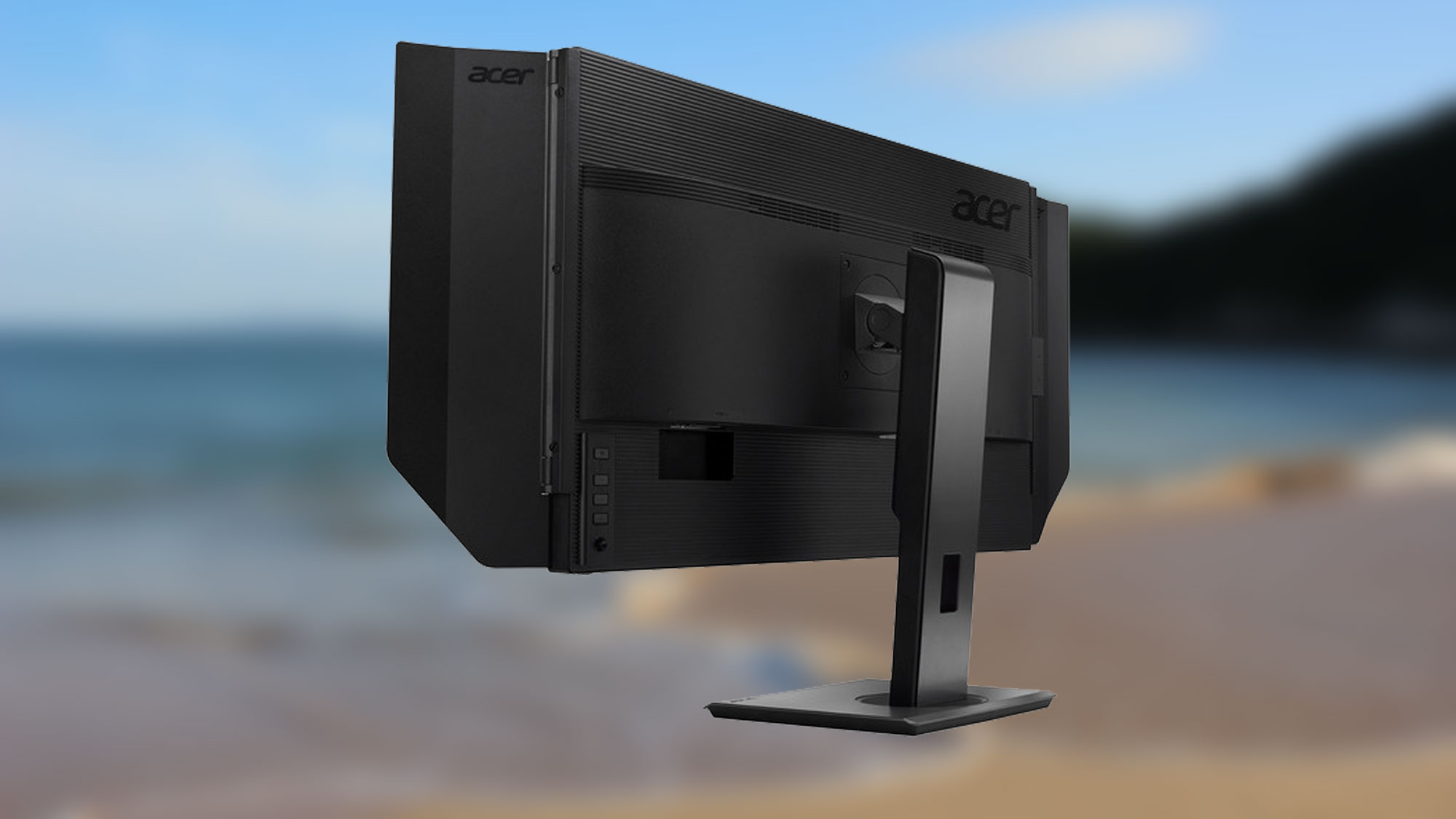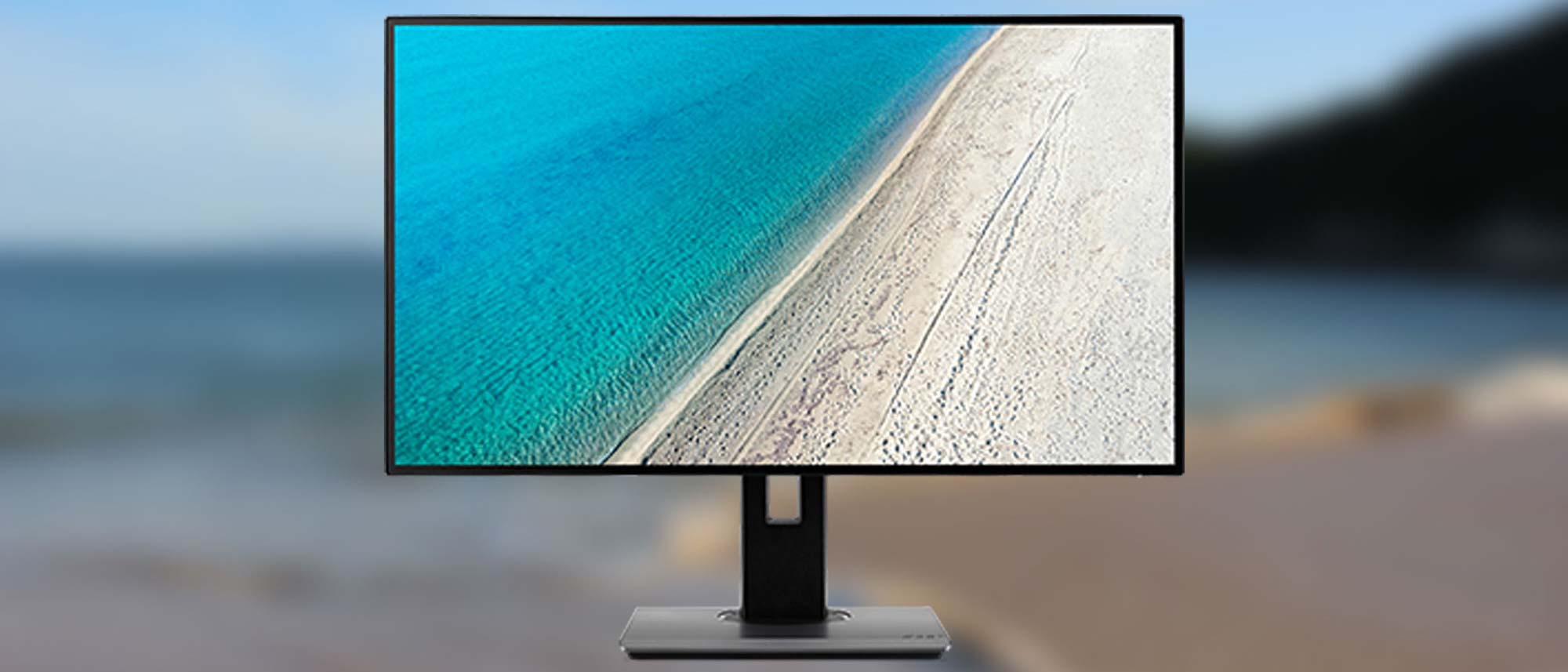Tom's Guide Verdict
The Acer PEO Series ProDesigner PE320QK is a display for pros with accurate color, 4K resolution, HDR10 support and even some gaming capability.
Pros
- +
Excellent color with preset color space modes
- +
Built-in display hood and anti-glare layer
- +
Great color accuracy and wide color gamut
- +
AMD FreeSync support
Cons
- -
Slightly irregular backlight
- -
Some presets remove customization options
- -
Middling audio quality
Why you can trust Tom's Guide
When visuals are your job, be it for print graphics, video content or any other visual medium, color isn't just important, it's essential. The Acer PEO Series ProDesigner PE320QK ($799) is made for color accuracy, giving designers and creators a 32-inch 4K display that looks great and offers technical accuracy to satisfy the pickiest professionals.
A quick rundown of the key features should spell out the appeal for pros: Factory calibration, 4k resolution, HDR10 and DCI-P3 support, as well as AMD FreeSync and a built-in display hood. If you're looking for a 4K monitor that lets you do your best work, with accurate color and no fiddling with extensive calibration, the Acer PEO Series ProDesigner PE320QK is a great choice.
Acer PE320QK design
Just looking at the PE320QK, the monitor has a look that says it's all business. With a 32-inch IPS panel, the focus is on picture quality. The monitor comes with a four-piece screen hood that borders the display on three sides to cut down on glare and ambient light. With the display hood removed, the monitor has slim 0.3-inch bezels around the display. Those narrow bezels will be especially nice should you want to double up and use two or more Acer PEO monitors side by side.

The hood is lined with a black, velvety material that absorbs light to further cut down on glare. In addition, it has a small trap door in the top piece that opens to let a calibration meter hang down the front of the display for fine-tuning the monitor's color quality.
The accompanying stand is also professionally minded, with height and angle adjustment that lets you raise the display 4.5 inches and rotate it side to side, up and down or even rotate it 90 degrees into portrait mode.
Measuring 16.3 x 29.3 x 7 inches, the large monitor has a fairly reasonable footprint. The highly adjustable stand has a square base that doesn't extend past the front of the monitor, leaving plenty of room on your desk for keyboard and mouse, or even tools like a Wacom drawing pad. And while the 17.8-pound weight is heavy enough that you may not move the monitor very often, it's not out of line for a 32-inch model.
If you want to mount the PE320QK on the wall or an adjustable monitor arm, the stand can be removed and a standard 100 x 100 millimeter VESA mount used instead.
Acer PE320QK ports and interface
The PE320QK has a good selection of ports, boasting both video inputs and a built-in USB 3.0 hub. On the back of the display you will find an input panel with two HDMI 2.0 ports, one DisplayPort 1.2 connection and a pair of USB 3.0 ports. A USB type-C port is also available, which can be used as a video connection or to charge a USB-C-equipped laptop or phone. On the side of the display is a dual USB hub that lets you connect storage and other devices without having to plug directly into your PC.

The display's primary interface is a four-directional joystick that doubles as a clickable button on the back of the display. This handy navigation tool lets you move through menus quickly, selecting items intuitively. In addition, there are four buttons on the back side of the right-hand edge of the display. One is a power button for the monitor, while the other three offer various contextual functions depending on the on-screen menu.
Acer PE320QK performance
Every PE320QK is calibrated in the factory, coming pre-tuned for optimal performance. Combine this with the laundry list of professional-grade features offered by the monitor, such as HDR 10 support, 10-bit color and AMD FreeSync support, and it's no surprise that the PE320QK delivers great visuals and superb color quality.
When I watched the 4K trailer for the Black Widow movie, I was pleased to see that the black and red shades featured prominently in the clip came through fairly deep for the black levels and vibrant crimson, as well as blue skies and bright orange flames.
My only complaints about color is that, like most backlit LCD displays, the blacks were just a little bit gray. If you want true, inky blacks, get an OLED display. I also found that the backlight isn't consistent; there are very minor variations in brightness across the 32-inch screen. You won't notice it when browsing the web or working on a document, but if you pull up a full-screen single-color test pattern, you'll see slightly brighter hot spots along the top and bottom edges of the display. This could be a real issue when doing color-critical work on photos or other media, since that minor backlight variance could skew your perception of the color consistency in an image.
Other than this, however, I was pleased with the PE320QK overall. The color quality is very good, and the display handles subtle variations in hues quite well, as expected for a 10-bit panel.
Besides media work, the monitor should also do well for less serious use, such as gaming. And while the expectations may be different when enjoying a game, the demand for accuracy, crisp detail and fast response times may actually be higher.
Thankfully, the Acer has several gaming-friendly features, including AMD FreeSync, which delivers variable frame rates between 30 and 60 hz to match the output of your graphics card and produce a smooth, tear-free gaming experience.
The gaming support isn't as rich as you'd get on a dedicated gaming monitor, however. Compared with something like the LG 38GL950G UltraGear, you'll find that the PE320QK has lower frame-rate support – 60Hz, as compared with the 144Hz of the LG 38GL950G – and none of the genre-specific game modes that are common to gaming displays.
Acer PE320QK lab test results
When we dialed up the screen brightness as high as it would go on the Acer PE320QK, we measured an average screen brightness of 237 nits using standard dynamic range content (SDR). While this is only about half the 550 nits the Acer claims the display can produce, this was done using standard dynamic range content. When we tested the display with HDR content instead of a basic white screen, we saw portions of the display reach 425 nits. When we switched the monitor over to the dedicated HDR mode, the results were much more in line with Acer's claims, measuring a peak brightness of 512 nits and an average brightness of 503, according to our equipment.
Honestly, any monitor that delivers more than 300 nits is pretty bright, as we've seen plenty that fall below that threshold, like the AOC C4008VU8 (286.8 nits), the BenQ EL2870U (249.5 nits) and the LG 27UD88-W (229 nits). The LG 38GL950G UltraGear does better, with a tested 544.4 nits, but it's also a high-end gaming monitor, so we aren't surprised by that performance.
The display also did well in other lab tests, delivering 108.7% of the sRGB color spectrum in standard mode, an improvement over displays that offer only 100% or close to it. When set to the specific sRGB picture mode, the results locked in right at 99.998% – the closest to true 100% we've ever tested.When switched over to HDR mode, which uses a larger color space, that same test bumped up the color gamut coverage to 123%.
That wider color space will give you a broad range of color and more intermediate shades to work with when color grading photos and video. Again, this is an improvement over the LG 27UD88-W (97.6%), but it falls short of the standard set by others, like the BenQ EL2870U (122%) and the AOC C4008VU8 (145%). According to our colorimeter and test software, we also saw the display produce 77% of the P3 color space under standard mode, and 92% in HDR mode.
And finally, the color that the Acer offers is very, very good, with a Delta-E accuracy rating of 0.09 in standard mode. While any monitor that can produce a rating of less than 1 is excellent (zero is perfect), the level of precision expected on a professional grade monitor is higher, and we are pleased to see the Acer come through in that regard.
Even among top performers, like the AOC 40-inch 4K Monitor (C4008VU8) (0.24) and the LG 38GL950G UltraGear (0.24), that 0.09 score is superb. And it's noticeably better than the BenQ EL2870U (1.1 ) and the LG 27UD88-W (1.7), even though those are highly accurate displays in their own right.
Acer PE320QK audio
The Acer PE320 QK sports a pair of built-in speakers, each offering 2 watts of power. That's a nice touch if you want to ditch the headphones every once in a while, but the speakers themselves didn't offer the best quality.
When I was watching the 4K trailer for Black Widow, I found the speakers to be fairly lackluster. The overall volume was low, the sound was tinny, and the dialogue and sound effects were shallow and a little echoey. For better sound quality, consider a good headset or some of our best computer speakers.
Acer PE320QK modes and features
The PE320QK has a total of eight different picture modes, many of which focus on the different color spaces you might need to work in. There are modes specific to sRGB, Rec. 709, and HDR, along with a custom user mode, standard mode (the default), Eco mode for energy-efficient use, graphics mode and Movie mode for watching streaming media or video content.
The most interesting of these are the dedicated sRGB, Rec. 709 and HDR modes, since they are aimed at pros who need to tailor their monitor settings to specific color standards.
Both the sRGB and Rec. 709 modes adjust the brightness and color gamut to match those respective color spaces, essentially curtailing the display's wider gamut and color depth to match those less expansive standards. The result isn't as impressive visually, but it isn't meant to be; it's meant to fall within the desired range for accuracy in the end product, be it a video, website, poster or whatever else.
The only issue we saw with these modes is that other settings are disabled to prevent the user from switching to sRGB mode, and then tweaking the settings right back out as they try to optimize the display. That's great if the preset meets your needs, but might be frustrating if you wanted to make a minor adjustment that stays within the given color parameters.
Bottom line
The real promise of the Acer PEO Series ProDesigner PE320QK is simple: a wide-screen 4K monitor that's made to support professional users in their work, with the visual accuracy that's needed when color and resolution are paramount. It's a great choice for anyone who works with photos, graphics or video, and the results we saw in our testing suggests it will be a solid performer in any studio or creative shop.
We were also pleasantly surprised by the PE320QK's less professionally minded offerings: It offers a surprisingly robust gaming experience for a non-gaming monitor. It's not as good as many of the gaming-specific products out there, but then again, they aren't great for professional use, either. If you want a gaming monitor, check out the LG 38GL950G UltraGear, our Editor's Choice for gaming. But if you're in need of a color-correct monitor that supports plenty of professional functions, the Acer PEO Series ProDesigner PE320QK is the best we've seen.
Brian Westover is currently Lead Analyst, PCs and Hardware at PCMag. Until recently, however, he was Senior Editor at Tom's Guide, where he led the site's TV coverage for several years, reviewing scores of sets and writing about everything from 8K to HDR to HDMI 2.1. He also put his computing knowledge to good use by reviewing many PCs and Mac devices, and also led our router and home networking coverage. Prior to joining Tom's Guide, he wrote for TopTenReviews and PCMag.


